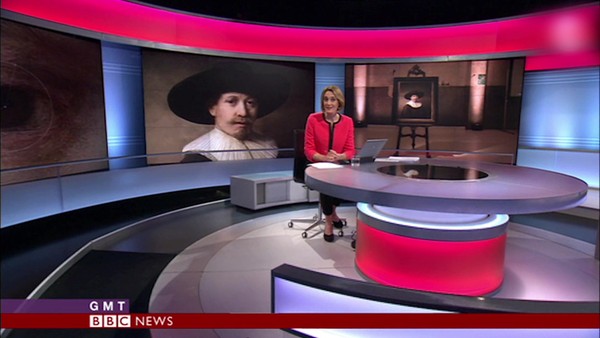Creative Data > Creative Data
THE NEXT REMBRANDT
J. WALTER THOMPSON AMSTERDAM, Amsterdam / ING BANK / 2016
Awards:

Overview
Credits
OVERVIEW
CampaignDescription
There is a vast collection of Rembrandt data available, most of it with a focus on a historical and art critique perspective about his life and craft. Very little scattered statistical data is available about the paintings themselves: like demography of subjects, colour analysis, material layering, and brush techniques.
So we conducted extensive multidisciplinary research into all of Rembrandt’s 346 paintings including studies of art history, historical pigments and materials, archival research, image analysis and data science. We wanted to know how to quantify Rembrandt’s craft, statistically understand his evolution as an artist, and teach a system how to replicate his style.
The final result is a 3D printed painting made solely of data derived from Rembrandt’s total body of work.
On the 5th of April 2016, the Next Rembrandt was unveiled at an exhibited in Amsterdam, the place where Rembrandt lived and worked.
MediaStrategy
Data is at the heart of the financial digital revolution. Up until now ING has focused his campings on presenting their consumer-end technological innovations and banking services. However, data has never been at the heart of any of these campings.
This campaign is different, fully data led. During the first phase, data allowed us to understand the demography in Rembrandt’s oeuvre, select the best profile, extract features, and classify by recurrence and relevance the typical geometrical patterns used by Rembrandt to represent human features. This led to the composition of the portrait.
Data also played a key role in analysing the distribution of paint on canvases to recreate Rembrandt’s brushstrokes, which were brought to life in the final printing of the portrait. And so, data became the brush inspired by Rembrandt’s statistical analysis.
The Next Rembrandt is where data meets creativity. Driven by a strong inventiveness and an unorthodox approach to understand the hidden stories that data can tell us.
It has an impact because it asks fundamental questions: What is creativity? Can emotions be measured? What is the real value of data in our lives? What is the limit of creativity?
Outcome
People from all over the world came to experience the unveiling and exhibition of The Next Rembrandt in Amsterdam. There the conversation about where data and technology can take us, started. A conversation that went global.
The Next Rembrandt was global trending topic, reporting almost 10 million Twitter impressions on the day of the unveiling.
Over 1.400 articles were written.
All the major news networks covered the unveiling and commented on its meaning for future innovations.
Globally over 1.8 billion media impressions were measured.
The total earned media value of the project amounted to 12.5 milllion euro.
On launch day Fortune Magazine reported an increase in stock value for ING (ING ^1.22%) and partner Microsoft (MSFT ^ 0.49%).
And in the weeks after the launch, Google reported an increase of ING’s Search Interest by 61.29%, and Microsoft’s by 20%.
To benefit future innovations, together with Microsoft, parts of the code will be made open source.
Next to the ongoing global conversation about what this painting means for our industry and the future of creativity, there was another fundamental result: the technology developed for The Next Rembrandt is now used for the restauration of damaged and partially lost Masterpieces.
Relevancy
Data has a story to tell us. But in most cases, that story is about people living today. What would happen if data was used to give us insights about people who lived over 350 years ago?
The Next Rembrandt is bringing back to life the Master of Light and Shadow by a multidisciplinary of academic experts, data scientists and software engineers that discovered innovative ways to leverage historical and statistical data.
A provocative project that rises fundamental questions for our industry. It creates a forum reflecting on the connection between creativity and technology, subjective and objective, craft and imagination.
Strategy
The starting point was the classification of the human population in Rembrandt’s integral oeuvre. Using as an input a combination of image analysis and historical data, a database was generated with a segmentation of age, gender, ethnicity and costume. The goal of the research was to figure out the most representative subject profile from a statistical perspective: man, between 30 and 40 years old, caucasian, with facial hair, facing to the right.
Once segmented, the profiled paintings were analysed using a face recognition algorithm to extract the most prominent facial patterns and generate a representative face in terms of geometry and composition: eyes, nose, mouth, ears, skin, eyes colour, face proportions, clothes and light conditions. The custom-made software reconstructed a portrait following Rembrandt’s composition style.
Finally, using x-ray scans of Rembrandt’s paintings, the software was capable of identifying patterns of brush strokes. After learning those patterns, the system mimicked the brushstrokes over the generated 2D image.
A 3D printer specially designed to make high end reproductions was used to create the painting. 13 layers of UV-ink were printed to create a realistic painting texture.
Resulting, after 18 months, in a new Rembrandt-portrait made of data of over 11 billion pixels.
Synopsis
ING, a Dutch multinational banking group, has been building its credentials as an innovative bank.
It has introduced many innovative solutions to provide its clients. From the introduction of fingerprint log-in to an in-house studio for Fintech startups.
All of these projects involved innovative technology but none of them specifically called out ING’s particular skill in data – a key characteristic of innovative companies today.
For many years ING has been supporting Dutch art and culture - a world that’s riddled with tradition, rather than innovation – and so ‘art’ became the natural arena for this new work.
By leveraging vast amounts of Rembrandt data, historical and statistical, the project shows how research and exploration can be a major driver for creativity. And how the marriage of data and creativity can build brand engagement and inspiration for consumers.
Inspiration, in the end, is the fuel for innovation.
More Entries from Creative Data Collection & Research in Creative Data
24 items
More Entries from J. WALTER THOMPSON AMSTERDAM
24 items













